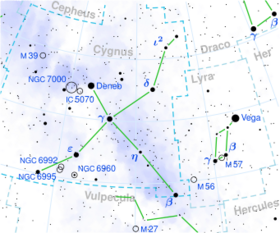Astronomy:Nu Cygni
From HandWiki
Short description: Star in the constellation Cygnus
| Observation data Equinox J2000.0]] (ICRS) | |
|---|---|
| Constellation | Cygnus |
| Right ascension | 20h 57m 10.41907s[1] |
| Declination | 41° 10′ 01.6991″[1] |
| Apparent magnitude (V) | 3.94 [2] |
| Characteristics | |
| Spectral type | A0III n[3] |
| U−B color index | +0.00[2] |
| B−V color index | +0.02[2] |
| Astrometry | |
| Radial velocity (Rv) | −27.60[4] km/s |
| Proper motion (μ) | RA: +9.64[1] mas/yr Dec.: −22.75[1] mas/yr |
| Parallax (π) | 8.71 ± 0.34[1] mas |
| Distance | 370 ± 10 ly (115 ± 4 pc) |
| Absolute magnitude (MV) | −1.36[5] |
| Details | |
| ν Cyg A | |
| Mass | 3.62±0.08[6] M☉ |
| Radius | 1.90[7] R☉ |
| Luminosity | 412[6] L☉ |
| Temperature | 9,462[6] K |
| Rotational velocity (v sin i) | 217[6] km/s |
| Other designations | |
| Database references | |
| SIMBAD | data |
Nu Cygni, Latinized from ν Cygni, is a binary star[9] system in the constellation Cygnus. Its apparent magnitude is 3.94[2] and it is approximately 374 light years away based on parallax.[1] The brighter component is a magnitude 4.07 A-type giant star with a stellar classification of A0III n,[3] where the 'n' indicates broad "nebulous" absorption lines due to rapid rotation. This white-hued star has an estimated 3.6[6] times the mass of the Sun and about 1.9[7] times the Sun's radius. It is radiating 412[6] times the Sun's luminosity from its photosphere at an effective temperature of 9,462 K.[6] The magnitude 6.4 companion has an angular separation of 0.24" from the primary.[9]
References
- ↑ 1.0 1.1 1.2 1.3 1.4 1.5 van Leeuwen, F. (2007). "Validation of the new Hipparcos reduction". Astronomy and Astrophysics 474 (2): 653–664. doi:10.1051/0004-6361:20078357. Bibcode: 2007A&A...474..653V. http://www.aanda.org/articles/aa/full/2007/41/aa8357-07/aa8357-07.html. Vizier catalog entry
- ↑ 2.0 2.1 2.2 2.3 Ducati, J. R. (2002). "VizieR Online Data Catalog: Catalogue of Stellar Photometry in Johnson's 11-color system". CDS/ADC Collection of Electronic Catalogues 2237: 0. Bibcode: 2002yCat.2237....0D.
- ↑ 3.0 3.1 Abt, Helmut A; Morrell, Nidia I (1995). "The Relation between Rotational Velocities and Spectral Peculiarities among A-Type Stars". Astrophysical Journal Supplement 99: 135. doi:10.1086/192182. Bibcode: 1995ApJS...99..135A. Vizier catalog entry
- ↑ Gontcharov, G. A. (November 2006). "Pulkovo Compilation of Radial Velocities for 35 495 Hipparcos stars in a common system". Astronomy Letters 32 (11): 759–771. doi:10.1134/S1063773706110065. Bibcode: 2006AstL...32..759G.
- ↑ Anderson, E.; Francis, Ch. (2012), "XHIP: An extended hipparcos compilation", Astronomy Letters 38 (5): 331, doi:10.1134/S1063773712050015, Bibcode: 2012AstL...38..331A.
- ↑ 6.0 6.1 6.2 6.3 6.4 6.5 6.6 Zorec, J.; Royer, F. (January 2012), "Rotational velocities of A-type stars. IV. Evolution of rotational velocities", Astronomy & Astrophysics 537: A120, doi:10.1051/0004-6361/201117691, Bibcode: 2012A&A...537A.120Z.
- ↑ 7.0 7.1 Pasinetti Fracassini, L. E.; Pastori, L.; Covino, S.; Pozzi, A. (February 2001), "Catalogue of Apparent Diameters and Absolute Radii of Stars (CADARS) - Third edition", Astronomy and Astrophysics 367 (2): 521–524, doi:10.1051/0004-6361:20000451, Bibcode: 2001A&A...367..521P Vizier catalog entry
- ↑ "* nu. Cyg". SIMBAD. Centre de données astronomiques de Strasbourg. http://simbad.u-strasbg.fr/simbad/sim-basic?Ident=%2A+nu.+Cyg.
- ↑ 9.0 9.1 Eggleton, P. P.; Tokovinin, A. A. (September 2008), "A catalogue of multiplicity among bright stellar systems", Monthly Notices of the Royal Astronomical Society 389 (2): 869–879, doi:10.1111/j.1365-2966.2008.13596.x, Bibcode: 2008MNRAS.389..869E Vizier catalog entry
 |


